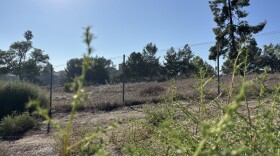This week was supposed to be the start of a brand-new school year for the 200,000, or so, students in the Houston Independent School District.
Instead, kids, teachers and staff are dealing with the fallout from Harvey's record-breaking rainfall and devastating floods.
Richard Carranza, Houston schools superintendent, is trying to figure out when school can start — and where, in cases where high waters flooded out schools and homes. Even as he recognizes this school year will be very different, he says the focus will be on teaching kids, wherever Harvey has scattered them.
"In no way, shape or form do I feel this is going to be a lost year," says Carranza. "I have every expectation that, you know, we'll look back at the end of the school year and just be tremendously proud of how our city came together, how the nation came to wrap its arms around Houston."
The school district announced that it will be able to provide all students this school year with three free meals. The majority of students in Houston public schools are low-income and given the current circumstances, free meals could be welcome news for many families.
Before then, though, the first step to opening schools is to make sure the city's streets and other infrastructure can handle thousands of children and teachers back on the roads. And Carranza is working closely with the mayor, the police chief and other officials to make that happen.
The Houston school district also has to check its own infrastructure — how many campuses suffered damage and where kids can study. Carranza also needs to see which teachers are ready to come back. Many of them have also evacuated or suffered loss.
"Obviously, if any one of those three is not in a state of preparedness, we just won't be able to open school on Tuesday as planned. So we're moving with all haste," Carranza says. He's hoping to make a decision by late this week.
The nation's seventh largest district has just over 280 schools. Carranza says that it's hard to know how many suffered damage because some are still inaccessible due to floodwaters. District crews have been heading to schools — sometimes in boats — to check them out.
As of Tuesday, the district had been able to assess 75 campuses. About half had damage, ranging from minimal leakage to feet of flooding.
Dozens of other school districts across the region — with over a million school children — are dealing with the aftermath of Harvey. Carranza says he's spent every evening on the phone with other superintendents to check in and assess the situation — sharing advice and support.
Carranza says some of those school chiefs, as well as others from Louisiana and around the country, have dealt with this kind of crisis before. They've already shared some lessons on how to get through Harvey's wake.
"Number one, you just have to accept the fact that post the tragedy, that things will be in disarray and it may be in disarray for months," he says.
But just as much, he says, the district will do everything to serve its children where they are. If that means some campuses require months of repair, Houston may consolidate campuses for a time. Or if thousands of children are living in the city's mega shelters, like the downtown convention center where there are now 8,000 evacuees, the district may send school buses to take students to and from class.
Through it all, he says, the district is aggressively trying to communicate with its students and staff over social media and the website, in both English and Spanish.
For Carranza, who's just starting his second year at the helm of Houston's schools, Harvey has created what he calls, "The most difficult time in his professional career."
"I'm heartbroken for our families and I'm heartbroken for our employees and I'm heartbroken for our city because we're going to be in pain for a little while. I think the more we can do to come together, the better."
Copyright 2017 Houston Public Media News 88.7. To see more, visit Houston Public Media News 88.7.






